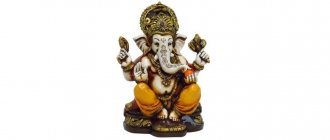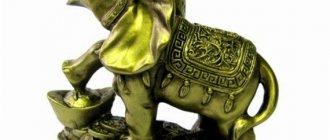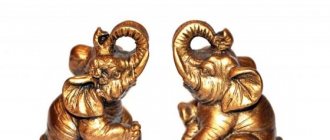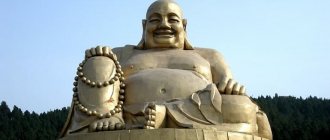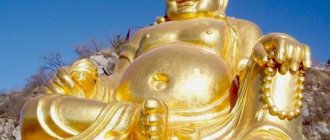The meaning of the elephant figurine: what does it mean as a symbol?
The elephant has always been considered one of the main symbols according to the teachings of Feng Shui. It is not for nothing that in some countries it is considered a sacred animal. So a talisman in the form of an elephant will bring many positive qualities, namely:
- wisdom;
- kindness;
- stability;
- longevity.
And most importantly, the figure of an elephant itself attracts good luck to the home; this can be compared to the way an elephant drinks water through its trunk. It draws it in with such force that the house will simply be filled with luck. Even a little elephant will “work” and bring love, trust and warmth of soul into the house. Moreover, there will be an influx of Qi energy, i.e. positive energy.
Owners in whose homes there is a talisman in the form of an elephant will also spend their savings more moderately; the elephant will keep them from thoughtless and large waste. Much depends on the position of the figurine’s trunk. If it is raised up, it means there is wealth. And if he looks down, then this means motherhood.
The elephant itself is a powerful animal, it stands confidently on its strong legs, like pillars, and the same stability in relationships and business will be observed in the house. You, like an elephant, will stand firm through life.
How to activate the elephant talisman
Experts say that the energy of the talisman itself is strong - it does not require intervention. Therefore, you should not try to activate the talisman on your own.
The only thing that will endear you to the elephant is jewelry. The Feng Shui symbol can be complemented with unusual pendants with precious stones, beautiful bracelets or chains. Earrings are perfect.
In the East, it is customary to hang a rosary (cypress or sandalwood) on a drawing or photograph of an elephant.
It is worth remembering that the use of ivory is strictly prohibited - your amulet will be offended. And you are unlikely to receive the desired protection from him.
What do popular types of talisman symbolize: the meaning of different compositions
There are many types of figurines themselves. Let's look at which one is right for you and what they mean.
We recommend: The power of magic. Black cat talisman, its meaning and manufacture
White albino
It stands to protect the house from the flow of negative energy. And it will definitely protect the family from various troubles.
Mother elephant with baby
This figurine simply needs to be placed on a young family if they want to have their own baby. Then motherhood is guaranteed. And if there are already children, then the elephant will protect them, just like her calf.
Three animals together
Three principles unite: earth, sky and man. Live as one.
Composition of seven figures
But a composition of seven elephants will ensure good luck in everything. If you place the figures of seven elephants, then you are guaranteed harmony in all areas of life (longevity, luck, love, good health, immense happiness, wealth and mutual understanding).
On coins
Well, here it is clear that it will increase material well-being and bring true wealth.
Important: if you put an ivory figurine of an elephant in the house, it will bring trouble to the owners. The figurine itself will only draw negative energy into the house. And there is no need to say why he acts this way.
With a hanging trunk
There are two opinions about this energy of this figure. Some believe that such a figure promises happy motherhood. According to another interpretation, she will only bring despondency and bad mood into the house.
Talisman "Seven Elephants"
You should take a closer look at the meaning of the “seven elephants” amulet, since this is a special figurine. Of course, one elephant will become your protector, but the energy that seven animals emit is enormous.
Seven has long had a reputation as a lucky number. It was worn as a talisman, as a messenger of good luck, as the protection of the Gods. The number 7 leads a person to complete harmony with the entire world around him and its inhabitants.
If you place the seven elephant talisman in your home, your family will always be happy, healthy and prosperous.
An oriental talisman animal will fill your home with real joy. You will never experience financial problems. The wisdom of the seven sacred animals will fill your mind with all the knowledge you need.
Where to put it in your home?
Let's look at how many elephants you can put in a house and what their number means. But you need to remember that you can put up a lot of figurines, but is it worth it? After all, everything should be in moderation.
- One elephant will bring additional charm and help you believe in yourself.
- Two elephants - and you are guaranteed to meet your loved one.
- Three elephants will set the mood for the arrival of a baby in the family.
- Four elephants will ensure financial stability.
- Five elephants will help you take an important step in life.
- Six will become helpers in love and bring good luck.
- Seven elephants, as already mentioned, will ensure harmony in everything.
- Eight elephants will help you overcome life's adversities.
- Nine elephants, if placed in a nursery, will help the child to better assimilate knowledge.
- Ten elephants. Once you have installed them, be prepared for big changes in your life.
- Eleven elephants - you will have excellent health.
We recommend: How to make an amulet for good luck and money with your own hands? Types of talismans to attract wealth
Now let's see where the figurines need to be placed:
- According to Feng Shui, elephant figurines can be placed in any part of the house, they will work everywhere. But the south-eastern part of the house is considered the most effective zone. There a strong foundation for the financial situation of household members will be formed.
- But if you need protection from the evil eye of an unkind person, then a figurine (a pair of elephants) should be placed near the front door. Elephants will greet people as they come.
- Elephants in the bedroom are the path to love and fidelity between spouses.
- In the workplace, elephants will also bring good luck.
- And by placing an elephant in the northwest, the head of the house will enlist its support.
But it’s worth repeating, the most important thing is not to overdo it. After all, harmony and balance according to Feng Shui are the main indicator. And too many figurines can have a negative impact.
Seven elephants for luck
For a very long time I wanted to make a talisman decoration, for good luck, for some reason the thought came to mind about elephants, which everyone loves so much, I started searching, reading, and this is what I found, I want to share!)
Once upon a time it was fashionable to have elephants in the house, and of course seven of them. They were displayed on a white embroidered napkin on a sideboard or chest of drawers: starting with the largest and ending with the smallest. Cute white elephants - marble or porcelain - were later recognized as philistine, removed from prominent places and were only sometimes found among grandmothers among old things... But time passed, the era changed, and elephants reappeared at flea markets and appeared in antique shops. They are again placed in a prominent place, often without thinking, simply out of habit. But what does this symbol, which came to us from distant India, mean?..
The elephant as a symbol is found among different peoples and in different cultures, but in Russia it is primarily associated with India. In Ancient India, the elephant was a symbol of sacred wisdom, royal dignity, invincible power and prudence. The mighty Indra, the head of the pantheon, rides around his domain on a beautiful white elephant, Airavata. Airavate in ancient Indian mythology is the first celestial elephant, who became the progenitor of all elephants; it is considered to be the mount and war elephant of the god Indra. According to one of the myths, Airavata is the main of the 8 white cosmic elephants that were born from the shell of the world egg during the creation of the world and guarded all directions of the world. Airavata is considered the guardian of the East; he is powerful and fearless in battle. His strength and valor is evidenced by the expression common in ancient myths: “Like Airavata in battle.” The first descendants of Airavata were snow-white winged elephants that flew through the air. One day they disturbed the sage's peace, for which they were cursed and lost the ability to fly. In India, there is still a belief that white elephants are endowed with the magical gift of creating clouds...
Ganesha is the most revered deity in India after Vishnu, Shiva and their wives. He is depicted with the head of an elephant on a human body. Ganesha is the god of foresight and wisdom; all Hindus call on him as the remover of all kinds of obstacles before starting any business. Ganesha is also the god of literature. According to legend, the great epic “Mahabharata” was written with the tusk of Ganesha. “If a Hindu builds a house, then before that he pleases the image of Ganesha and installs it at the construction site or nearby; if he writes a book, then at the very beginning he pays tribute to Ganesha, since he is the patron of literally every written sign. When going on a trip, he prays to Ganesha for protection, and for the convenience of travelers, his image is often placed on the side of roads, especially at intersections... The figure of the god of prudence can usually be seen above a store or bank. And above all else, there is perhaps no deity in the Hindu pantheon who is so often invoked and seen so often.”
In Buddhism, the elephant is the most revered sacred animal, a symbol of spiritual knowledge and stability, it is dedicated to the Buddha, since a white elephant appeared to Queen Maya in a dream, announcing the birth of the royal ruler of the world, Buddha Gautama. The white elephant is a symbol of the Bodhisattva, the liberator of people from the shackles of earthly existence. It is a symbol of compassion, love, kindness and prudence. He is also one of the Jewels of the Law, the mount, the "vahana" of the Bodhisattva. Akshobhya sits on a white elephant. In the Greco-Roman tradition, the elephant is an attribute of Mercury, an emblem of wisdom. Pliny calls the elephant a religious animal, worshiping the Sun and the stars, purifying itself at the new moon, when, bathing in the river, it calls on Heaven. In the ideas of the ancient Romans, the elephant was associated with victory and in the visual arts it personified Glory, and also meant longevity, immortality, and victory over death. Later, these ideas were reflected in the Christian tradition, where the elephant became a symbol of Christ’s victory over death and evil - in this case, the elephant is depicted trampling a snake.
For medieval people, the elephant was a symbol not so much of Christ as of the fight against Satan. The elephant is a symbol of the Crusaders, this animal was depicted with a tower full of archers on its back. The elephant is a symbol of the fight against world evil; it is often depicted fighting a dragon, which, like Satan, lies in wait for elephants, entangles their legs with its long tail and strangles them with its long neck. In medieval Europe, the elephant, along with the unicorn, was classified as a mythical animal found only in fairy tales, since few Europeans at that time had seen a living elephant. The elephant is often found in paintings of paradise, and since the Crusades its image has appeared on coats of arms. Europeans received elephants from time to time as gifts from various eastern rulers. And this is very symbolic: light came from the East, Christ was born in the East, and the elephants are from there. In this sense, the story of A.I. is very interesting. Kuprin, one of the best stories for children written in Russia, is a story about a girl who recovered from a serious illness when an elephant was brought to her apartment at her request - a simple and touching paraphrase of the gospel miracle of Jesus’ resurrection of the daughter of a rich Jew. The elephant represents wisdom, strength and prudence. In India, China and Africa, it serves as an emblem of royal power and symbolizes the qualities necessary for a good ruler - dignity, insight, intelligence, patience, as well as loyalty, peacefulness, longevity, prosperity and happiness. In the countries of Asia and Africa, the elephant, as an emblem, plays the same role as the eagle or lion in the countries of Europe and America. In Thailand, Cambodia and Burma, the white elephant became a similar symbol of fertility and rainfall. The white elephant was also a symbol of the Kingdom of Siam (now Thailand). In China, they believe that riding an elephant in a dream promises happiness...
The elephant symbol is actively used in Feng Shui, where the elephant is an auspicious animal, a symbol of stability and stability. It is believed that, thanks to its trunk, the elephant can draw good luck and prosperity into the house, as it can get something from afar. Therefore, it is recommended to place the elephant on the windowsill with its trunk in the direction of a good star. Thus, the elephant draws luck from the street into the house through the window. If the elephant turns its trunk inside the apartment or house, this will mean that good luck is already in this house. Where is it better to place the figurine with the elephant? To attract monetary energy, an elephant should be placed in the wealth sector, and in the assistant sector - to attract a patron and support the head of the family, since the elephant is a symbol of power and indestructible strength. To activate the talisman, you just need to decorate the elephant. Hang gemstone beads or a beautiful chain around the figurine’s neck. If the talisman is made in the form of an image, you can hang rosary beads made of sandalwood, cypress or amber from the picture. But under no circumstances hang ivory beads, this may anger the elephant and his revenge for his dead brothers will fall on the inhabitants of the house.
In the East, the elephant is symbolized with longevity, because it lives quite a long time, and also with moderation - these animals are very unpretentious in food and drink, so their images and figurines help people refrain from excessive spending. This, of course, primarily concerns women and so-called shopaholics. So what exactly is an elephant? This is beautifully told in a parable, the heroes of which - three blind men - wanted to find out what an elephant is. One felt his leg and said: “An elephant is like a column.” Another touched the animal's tail and said, "An elephant is like a rope." The third touched the trunk and said: “An elephant is like a snake.” Not a single one guessed right. However, we recommend that you definitely buy cute elephants made of porcelain, marble, wood or any other material and place them in a row of seven pieces (the magic number!) on a napkin. Give elephants to friends and family - if only because giving a family of seven elephants is an ancient Indian tradition that expresses the wish for happiness and longevity: a string of elephants reminds of eternity, and the seven gives mystical power to the wish...
How to clean and activate?
But now that we have decided which elephant figures we will place, where and how many, we need to activate them. Elephant talismans are very powerful in themselves, but you can make them work even better. You should hang some kind of decoration on the figurine, preferably beads. The elephant has a weakness for jewelry.
Important: under no circumstances should you hang ivory jewelry on an elephant figurine. This will turn on the reverse (negative) process of the talisman.
It is advisable to choose jewelry from semi-precious stones and precious metals (gold, silver). After you purchase a figurine, it must be cleansed of negative energy. To do this, wash the product with salted water.
There is no need to place elephant figures throughout the home. They cannot bring you all material and intangible benefits at once. If you really need something, then focus special attention on it. And you will be happy. Previous
The talisman is the Unity of opposites and the four main elements in the Pentacle of Solomon. Amulet power, making and purification
Next
A talisman is a personal amulet: how to choose a talisman based on your date of birth and zodiac sign?
Topiary figures - a fashionable trend in landscape design
Garden topiary is an art that came to us in Russia from Central Europe back in the 17th century.
And in Europe, this most interesting trend has its roots in the culture of Ancient Rome. Translated from Latin, “topiary” is “ornamental art”, and “topiaryus” is “gardener”. Initially, the art of topiary was understood as the artistic pruning of trees and shrubs, and only at the beginning of the 20th century they came up with the idea of using a rigid frame so that plants of suitable bindweed varieties would entwine it, thereby forming topiary figures of the required shape.
Today, the art of garden topiary has moved even further. With the invention of modern materials and technologies, it became possible to produce topiary figures from artificial turf, which is indistinguishable from real grass and has many advantages over it.
Topiary figures are experiencing a new round of relevance at the beginning of the 21st century, and this trend in landscape design is only intensifying every year.
Advantages of artificial grass garden figures
- Topiary figures made from artificial turf will not dry out or wither. They do not require maintenance or watering and do not rot or corrode.
- The sculptures will delight you with their pristine appearance not only in summer, but also in the cold season.
- Figures made from high-quality artificial grass can be installed in any corner of the garden, since they are not demanding on the amount of sunlight. They can also be installed indoors.
- You purchase garden topiary today to use sculptures in your landscape for many years to come!
What does an elephant mean to Europeans?
Amulet and amulet in the form of an animal began to appear in Europe relatively recently. The figurines were brought by Indian and Chinese traders. Today, under the influence of Asian cultures and teachings, figurines and images of animals began to symbolize happiness, wisdom, and stability.
According to Feng Shui, the elephant attracts positive Qi energy, and in Hinduism the giant symbolizes protection, since these animals have long been used as part of the army. For the reasons listed above, an elephant is a suitable amulet for the home. It will be especially useful for:
- People who feel they have no control over their lives and want to find stability and protection.
- People in leadership positions.
- Mothers or women who will soon become them.
- Students and people undergoing training: the figurine will give them a sense of purpose.
- Families where they often quarrel: the giant is peaceful, so it will balance the atmosphere in the house.
- Those who are experiencing significant financial difficulties.
A figurine or image of an animal is placed in special places in the house to attract the necessary energy flows. Pay attention to the pose of the elephant.
